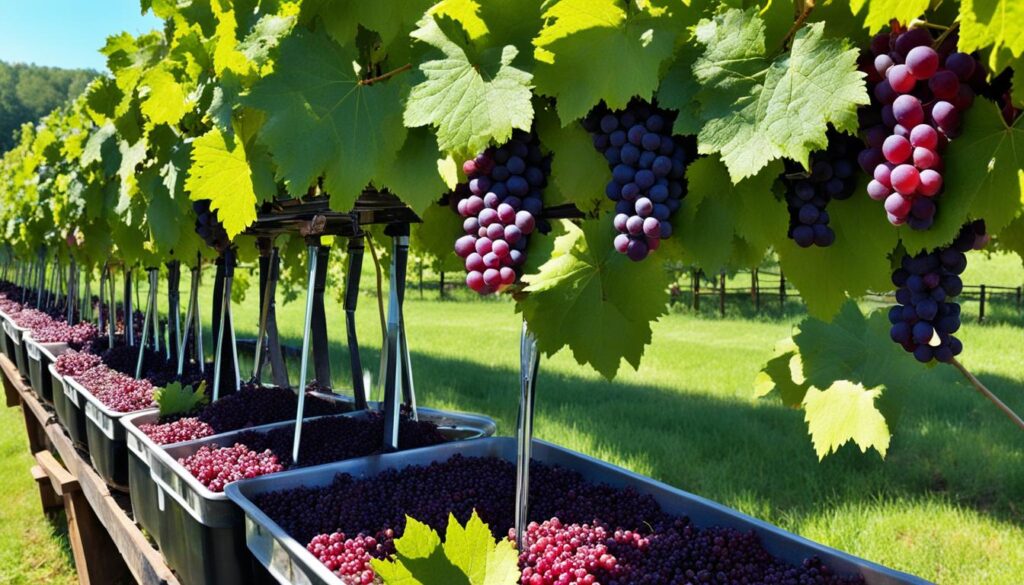Making Muscadine Wine: A Step-by-Step Guide

Have you ever wondered about the allure of muscadine grapes and their potential for crafting exceptional homemade wine? Muscadine grapes, native to the southeastern United States, possess a unique flavor profile and vibrant hues that set them apart from more commercially grown grape varieties. In this comprehensive guide, we’ll explore the art of making your own muscadine wine, from understanding the grape itself to the step-by-step winemaking process. Whether you’re a seasoned winemaker or a curious beginner, this article will equip you with the knowledge and techniques to create a delicious, one-of-a-kind muscadine wine in your own home.
Key Takeaways
- Muscadine grapes are a unique and flavorful variety native to the southeastern United States.
- Homemade muscadine wine can be crafted with a step-by-step winemaking process, even for beginners.
- Muscadine grapes come in a range of colors, from green and bronze to deep purple.
- Muscadine wine production is evolving to produce medium-bodied, sweeter wines suitable for dessert or post-dinner consumption.
- Muscadine wine does not require the addition of sulfites for preservation, with a recommended shelf life of 3-6 months.
Muscadine Grapes: A Southern Delight
Nestled in the warm, humid climate of the southeastern United States, a unique grape variety known as the muscadine thrives. These grapes, indigenous to this region, are a cherished part of the local culture and cuisine, offering a delightful taste of the South.
What are Muscadine Grapes?
Muscadine grapes, botanically known as Vitis rotundifolia, are distinguished by their large size, thick skins, and distinctive sweet-tart flavor. These grapes grow in clusters, similar to blueberries, rather than the traditional grape bunches. Ranging in color from green and bronze to deep purple, muscadine grapes are a true Southern treasure.
Muscadine vs. Scuppernong Grapes
A specific variety of muscadine grapes, the scuppernong, is particularly noteworthy. Typically greenish-bronze in color, scuppernongs boast a slightly tarter flavor compared to other muscadine cultivars. Both muscadine and scuppernong grapes are cherished for their unique characteristics and contributions to the rich culinary heritage of the South.
“Muscadine grapes have been extensively cultivated since the 16th Century in the southeastern United States, and have become a beloved part of the local culture and cuisine.”
With their exceptional disease resistance and high yields, muscadine grapes have played a significant role in the agricultural history of the region. From preserves and jams to the production of delectable wines, these grapes continue to captivate the palates of those who appreciate the flavors of the South.
How to Make Wine with Muscadine Grapes
Crafting delectable muscadine grape wine at home is a rewarding process that allows you to harness the unique flavors of this Southern fruit. Whether you’re aiming for a light and crisp white wine or a fuller-bodied red, the key is understanding the specific ingredients and step-by-step winemaking techniques.
Ingredients and Equipment Needed
To get started, you’ll need the following muscadine grape wine ingredients and equipment:
- Fresh, ripe muscadine grapes (approximately 1 gallon)
- Granulated sugar (around 8 pounds)
- Wine yeast
- A fermentation vessel, such as a food-grade plastic or glass carboy
- A strainer or cheesecloth
- A siphon hose
- Clean, sterilized bottles for bottling
- Other basic winemaking tools (hydrometer, thermometer, etc.)
Step-by-Step Winemaking Process
Follow these steps to craft your own delicious muscadine grape wine:
- Wash and crush the fresh muscadine grapes to release the juice and pulp.
- Add the granulated sugar and stir until fully dissolved.
- Sprinkle in the wine yeast and stir gently to incorporate.
- Transfer the grape must (juice, pulp, and skins) to the fermentation vessel, ensuring it is filled to within a few inches of the top.
- Allow the mixture to rest for at least 24 hours, allowing the yeast to activate.
- Secure the fermentation vessel with an airlock and let the wine ferment for 6-9 weeks, monitoring the specific gravity and temperature.
- Once fermentation is complete, use a siphon to transfer the clear wine into a clean vessel, leaving behind any sediment.
- Age the wine for several months in a cool, dark place, allowing it to mature and clarify.
- Finally, bottle the wine in clean, sterilized bottles and store them in a refrigerator or other cool location.
Proper sanitation and temperature control are crucial throughout the muscadine winemaking process to ensure a successful and safe final product.

“Sculpting the character of wine by controlling the amount of time pulp is in fermentation is employed by wineries, also applicable to white wines like Sauvignon Blanc.”
By following these steps and adjusting factors like fermentation time and aging, you can create a wide range of delightful muscadine grape wines to enjoy and share.
Fermenting Muscadine Grapes
The fermentation process is a critical stage in transforming your freshly crushed muscadine grapes into a delectable wine. Once you’ve prepared the must (the mixture of crushed grapes, juice, and any added sugars), it’s time to introduce the yeast and let the natural magic unfold.
To begin the fermentation, you’ll need to maintain a consistent temperature range of 70-75°F. This optimal temperature range ensures the yeast can efficiently convert the natural sugars in the muscadine grapes into alcohol. Regularly stirring the must and monitoring the specific gravity throughout the process will help you track the fermentation’s progress.
The primary fermentation period typically lasts 7-10 days. During this time, the yeast will be hard at work, vigorously converting the sugars. It’s essential to keep a close eye on the specific gravity, as you’ll want to ensure it reaches the desired level of around 1.090 before moving on to the next stage.
- After the initial grape crushing and sugar addition, the muscadine wine must undergo a primary fermentation period of 7-10 days.
- Maintaining the correct temperature range of 70-75°F is crucial for proper fermentation.
- Regularly stirring the must and monitoring the specific gravity will help ensure the fermentation process is progressing as intended.
By carefully managing the fermentation of your muscadine grapes, you’ll be well on your way to creating a truly exceptional and flavorful muscadine grape wine. The patience and attention to detail during this stage will pay off in the final product.
Aging and Bottling your Muscadine Wine
Once the initial fermentation of your muscadine wine is complete, it’s time to let the wine age and develop its full flavor profile. This secondary fermentation period typically lasts 4-6 weeks, allowing the wine to clarify and refine its character. After this crucial aging step, your muscadine wine can be carefully transferred to clean, sterilized bottles for long-term storage.
Proper Storage and Shelf Life
Proper storage is key to preserving the quality of your homemade muscadine wine. The ideal storage conditions involve a cool, dark place, such as a wine cellar or a dedicated wine refrigerator. Exposure to direct sunlight or fluctuating temperatures can cause the wine to deteriorate prematurely.
When stored correctly, your muscadine wine can typically last 3-6 months before beginning to lose its optimal flavor and aroma. However, some winemakers have reported their muscadine wines maintaining their vibrant character for up to a year or more, depending on the storage conditions and the specific wine blend.
To further extend the shelf life of your muscadine wine, consider using a few wine stabilizers, such as Campden tablets, Potassium sorbate, or Sodium benzoate. These additives can help prevent unwanted fermentation and maintain the wine’s stability over time.
Remember, the aging process is crucial for developing the full bodied, complex flavors of muscadine wine. By following proper storage techniques and utilizing wine stabilizers, you can ensure your homemade muscadine wine reaches its full potential and provides an exceptional drinking experience for months to come.

“The earliest evidence of stored wine dates back to 7,000 years ago in Iran, and the French began storing wine in specially designed wine caves centuries ago. Today, wine cellars and cabinets are considered the ideal wine storage locations.”
Muscadine Grape Wine Variations
Muscadine grapes are renowned for their natural sweetness, making them a popular choice for winemaking. However, there are various ways to further enhance the flavor and sweetness profile of muscadine wines. From adjusting the sugar content during the winemaking process to incorporating additional sweeteners and complementary fruit flavors, the possibilities are endless when it comes to creating unique muscadine wine variations.
Sweetening and Flavoring Options
One of the most straightforward ways to sweeten muscadine wine is by adjusting the amount of sugar added during the winemaking process. The recommended Brix range for muscadine and scuppernong grape juice is between 22.0-23.0, which can translate to a potential alcohol range of 10% to 13% for the finished wine.
In addition to manipulating the sugar content, winemakers can also experiment with different yeast strains or add complementary fruit flavors to create distinctive muscadine wine variations. For instance, some popular options include:
- Incorporating honey or fruit juices (such as apple, pear, or berry) during the secondary fermentation stage to enhance sweetness and add complex flavors.
- Utilizing different yeast strains, such as Lalvin K1V-1116 for scuppernong or Red Star Pasteur Blanc for muscadine, to influence the wine’s aromatic profile and mouthfeel.
- Aging the wine in oak barrels to impart subtle vanilla, spice, or toasted notes that can balance the wine’s natural sweetness.
The possibilities are endless when it comes to customizing muscadine wines. By experimenting with various sweetening and flavoring techniques, winemakers can create a diverse range of muscadine wine variations that cater to a wide array of personal preferences and palates.
“One of the oldest grapevines in the world is a Scuppernong, a Muscadine cultivar, planted around 1584 in Manteo on Roanoke Island.”
With their unique flavor profiles and the ability to be customized, muscadine grape wines offer a compelling alternative to more traditional grape varieties. By embracing the versatility of this Southern delight, winemakers can continue to push the boundaries of what’s possible in the world of muscadine wine.
Conclusion
Crafting your own homemade muscadine wine at home is a rewarding and enjoyable experience that allows you to capture the essence of the American South in a bottle. By following the step-by-step guide provided in this article, you can produce a high-quality, flavorful muscadine wine that can be savored and shared with friends and family. Whether you’re a seasoned winemaker or a newcomer to the craft, mastering the art of muscadine wine making is a valuable skill that can be endlessly explored and refined.
From sourcing the perfect Muscadine grapes to meticulously tracking the fermentation process, each step in the DIY muscadine wine journey presents an opportunity to hone your winemaking expertise. With the right equipment, knowledge, and a touch of patience, you can craft a unique and distinctive muscadine wine that reflects the rich heritage and terroir of the American South.
Whether you prefer a sweet, off-dry, or dry Muscadine wine, the versatility of this grape allows you to experiment and discover your personal taste preferences. As the popularity of Muscadine wines continues to grow, the opportunity to share your homemade creations with others and contribute to the vibrant culture of American viticulture is truly rewarding. Embrace the art of muscadine wine making and savor the fruits of your labor, one sip at a time.







